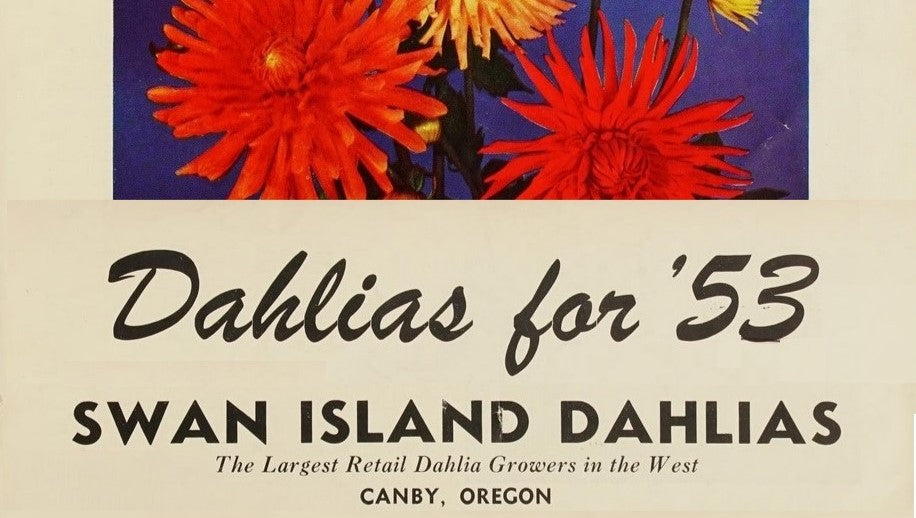This article is adapted from a dahlia catalog published in 1953 by Swan Island Dahlias of Canby, Oregon.
This publication is in the public domain.

Editor’s note: This article discusses gardening techniques which were commonly recommended at the time of original publication. Please note that some of these may no longer be considered best practices for dahlia growers. While this article contains some excellent information, please remember that it was written more than 100 years ago. Consult modern guides before relying on the techniques discussed here.
How to Grow Dahlias
Planting and Culture
Dahlias will grow in any garden soil, and superior flowers can be produced with a little extra care.
The ground should be in a moist growing condition at all times, especially during the blooming season.
After all danger of frost is past, plant the tubers in an open sunny location in holes four to six inches deep and two to three feet apart, either in rows or in mass effects.
If stakes are used for name tags and support later on, they should be set at planting time.
Cover the tuber with about two inches of soil and fill in as the sprout grows.
To avoid too tall a bush pinch out the top of the plant just under the first set of leaves when five or six side branches have appeared.
Water every week, soaking the ground thoroughly.

Fertilizer for Dahlias
Bone meal may be mixed with the soil in the hole at planting time—a small cupful to each plant. Commercial fertilizers may be used—rather sparingly—about three weeks between applications during the flowering season.
Be sure the dust does not get closer than four inches to the stalk. Immediate watering is advised.
Cow or sheep manures are good, especially for the humus content, but not horse manure, as it will give too rank a growth.
Insect Control for Dahlias
Insects on dahlias can be easily controlled by using DDT for thrips, leaf-hoppers, and cucumber or twelve spot beetles.
Any insecticide with a nicotine base can be used for aphids. Follow directions on the package. For red spiders use parathion, either dust or spray.
Dahlias as Cut Flowers
Dahlias should be cut when the blooms are fully matured, because they do not open out in water. An immature flower will wilt and one too old will shatter.
Pick them late at night or early in the morning, using a sharp knife to make a slanting cut.
Put them in deep cold water and let them stand several hours before arranging.
Scrape the stems slightly for about five to six inches at the base or dip the stems in very hot water for a minute or two. This will make the flowers last longer because it opens up the pores and allows them to absorb more water.

Digging & Storing Dahlia Tubers
Late in the fall, usually after a frost, cut the bushes off close to the ground.
Dig the clumps carefully, making sure the roots are not broken away from the stalk or the necks are not twisted or broken.
Trim off the stalk as close to the clump as possible. Store the clumps in crates or barrels in a place free from frost, but not so dry that tubers will shrivel.
A good rule to follow for storing dahlias is to keep them as you would potatoes.
Divide the clumps at planting time after the eyes or sprouts are easily seen. Never plant the whole clump. This will make a cluster of weaker bushes instead of one strong plant.
Dahlia Varieties for 1953
Please note that this information is provided for historic reference only. We do not have these dahlias for sale. One dollar in 1953 is worth about $11.50 today.




New “Dark Foliage” Dahlia
Japanese Bishop
This variety came unnamed to us from Japan two years ago.
Because of its similarity in both color and type of flower as well as foliage to Bishop of Llandaff we named this dahlia Japanese Bishop.
It created a sensation at our shows this past season and was ordered more than any other variety.

The daisy-like flowers are a rich deep red with the open centers outlined with a row of golden yellow pollen.
As the flower ages gold fills in the entire center. The foliage is exceptionally dark green, almost black, making the plant outstanding in any setting.
Because of the exceptionally heavy demand our stock will be rather limited, so order early to avoid disappointment. There is no substitution for this dahlia!






